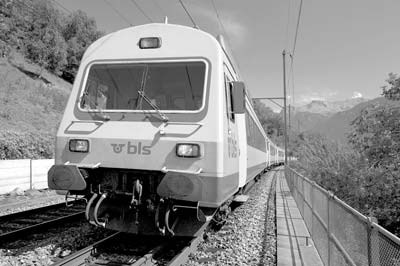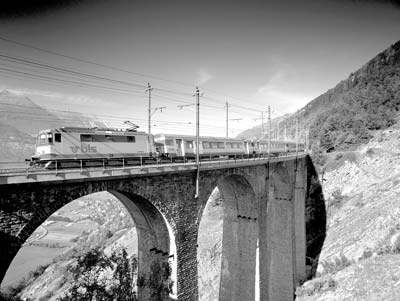More new developments at year’s end
by Jay Brunhouse
On Dec. 9, passenger trains will make their first 125-mph runs through Switzerland’s shorter, safer and more productive north-south Lötschberg Base Tunnel between Frutigen and Raron.
The CHF30 billion, 8-year construction of the lowest crossing of the Alps, at 2,717 feet, had a grassroots beginning.
In the ’70s, Swiss motorists began complaining that multiwheeled trailer trucks carrying goods without stopping between Germany and Italy were slowing highway flow through mid-Switzerland and backing up traffic. Irate citizens wrote their representatives and newspapers. The only things the Swiss were getting were headaches and potholes.
The representatives complained to the Swiss National Railroads (SBB). In 1984, SBB was forced to reveal its first ideas for bringing the rail network that had remained basically unchanged for over a hundred years into the 21st century.
Democracy in action
In 1987, some estimated 5.6 million voters approved by a surprising 57% margin massive improvements that eventually cost each Swiss taxpayer about $5,400. Does that sound like your hometown? Imposing weight limitations and tolls on international truck road traffic partially offset the cost but caused friction with the European Union and Switzerland’s larger neighbors, Germany and Italy.
SBB’s plan, named “Rail 2000,” was aimed at fundamentally modernizing the entire network over 20 years. It included the connection of SBB with the European High-Speed Network, noise remediation on SBB’s trunk lines, general raising of train speeds, shortening travel times by means of new tunnels and rolling stock, and scheduling more frequent departures — often quarter-hourly. The masterstroke was the boring of two base tunnels under the Alps for the Lötschberg and Simplon mainlines.
Base, or ground level, tunnels eliminate the need for heavy freight trains to crawl up and down mountainsides and the requirement for super-heavy-duty locomotives to pull them. To connect both slopes of the Alpine range, the tunnels must be extraordinarily long. The Lötschberg Base Tunnel is 21.5 miles long. The Simplon Base Tunnel, due 2015, will be 34.8 miles long.
Cisalpino
In December 2005, Cisalpino (CIS), the operating company held equally by SBB and the Italian State Railroads (FS), was granted total control of all conventional routes between Switzerland and Italy and added EC/IC rolling stock to their already existing fleet of tilting Cisalpino ETR470 trains used on the Lötschberg route.
The fleet of blue-and-white ETR 470 Pendolino tilting trains was derived from Italy’s ETR 460 Pendolino but are capable of running also on the Swiss electrical power supplies to navigate the twisting Swiss Alpine routes at higher speed.
Tilting is the well-developed system of rounding curves 20% faster to decrease overall travel time without unsettling passengers. Sensors in Cisalpino’s leading vehicle send messages to the Fiat tilt system, which tilts the carriages one after another per software instructions.
Starting in 2008, Cisalpino will receive 14 new ETR 610 tilting trains with avant-garde Giugiaro design.
The dual-voltage ETR 470 trains are geared lower than their Italian Pendolino predecessors so that they reach a maximum speed of 125 mph rather than the Italian’s 155 mph. This trade-off was necessary to give them higher traction for better climbing power over steep Swiss mountain routes. Remember how your bicycle and automobile climb hills better in low gear than in high.
The 9-carriage Cisalpino tilting trains offer 475 seats (153 first class, 322 second class). They are air-conditioned and airtight in order to make travel through tunnels more comfortable.
The interiors, designed by the Turin designer Giugiaro, sport seats separated by tables. Interiors are subdued, gray blue in first class, sea green in second. Earphone jacks for taped music are installed beside every seat. Long windows are equipped with sunscreens that you control electrically, but this is the downside of the Cisalpino: the shape of the windows. They are long, but vertically they limit your vision so severely that you must strain to see the mountain crests, which is a shame when traveling in a country as scenic as Switzerland.
Italian designers know how to do bar/restaurants right. They have provided Cisalpino 470s with only 25 seats for you in their intimate bar/restaurant car but positioned their dining space beneath a low, intimate, light-studded ceiling, making it one of the most beautiful dining areas on the rails.
Unfortunately, there is no dining car on the EC/IC stock that Cisalpino uses on the same route; the caterer offers a well-stocked food trolley instead.
Passengers who speed through the base tunnel save time but also miss the wonderful Lötschberg scenery. To compensate, the BLS Lötschberg Railroad will introduce new Regional Express trains to serve cities bypassed by the new base tunnel and take railway fans and nature lovers over the scenic mountain line to the Kander and the Lötschen valleys. As in the past, BLS will provide piggyback auto transportation between Kandersteg and Goppenstein or Iselle (Italy).
More European year-end highlights
• Phase Two of the $3.9 billion Channel Tunnel Rail Link was completed on Nov. 14, and Eurostar trains began serving London’s new St. Pancras International Station (replacing Waterloo International Station), cutting 23 to 25 minutes from the trip to and from Paris’ Gare du Nord to two hours 15 minutes and Brussels’ South Station to two hours flat.
The final phase of the British high-speed line consists of a 21-mile stretch of track from Ebbsfleet to London St. Pancras station as well as two new stations, a 2-mile tunnel under the Thames and a 12-mile twin tunnel into central London.
Passengers arriving at the $195 million restoration of St. Pancras have connections to seven mainline train services and nearby Kings Cross and Euston stations as well as six London underground lines.
• Beginning Dec. 9, GermanRail (DB) will launch five direct ICE 3MF high-speed train pairs between Paris and Frankfurt/Main, thus trimming the travel time from six hours six minutes to three hours 49 minutes.
In Germany, the line between Mannheim and Saarbrücken will have been upgraded to 125 mph and the Saarbrücken train station rebuilt and modernized into a “Eurobahnhof.” In France, the German trains will run at 199 mph over the new TGV Est line.
• Also on Dec. 9, direct ICE diesel services will begin between Berlin and Copenhagen. This will be the first direct rail connections between the two capital cities since discontinuing 10 years earlier. The journey time between Berlin and Århus will be reduced by more than half an hour, to less than seven hours. As well, diesel ICE trains will begin service on the Hamburg-Flensburg-Århus and Hamburg-Puttgarden-Copenhagen routes, replacing the crowded Danish IC trains currently in service.
I thank the Swiss Tourist Office (www.myswitzerland.com) for arranging the Swiss Pass issued by the Swiss Travel System. We stayed in Bern’s gleaming, 4-star Hotel Allegro (phone +41 [0] 31 339 55 00, www.allegro-hotel.ch), which is part of the Grand Casino Bern complex and a short walk or streetcar ride from Bern’s scenic center. Rates start at CHF145 (near $121).


